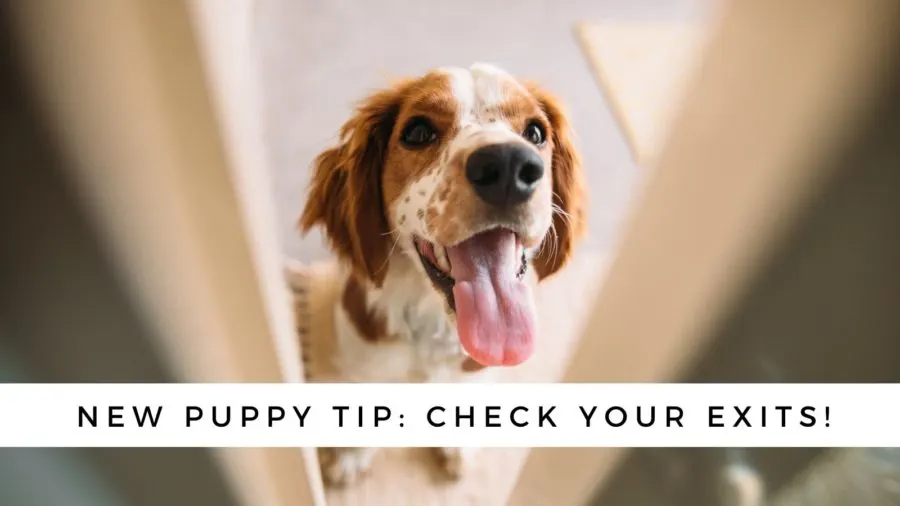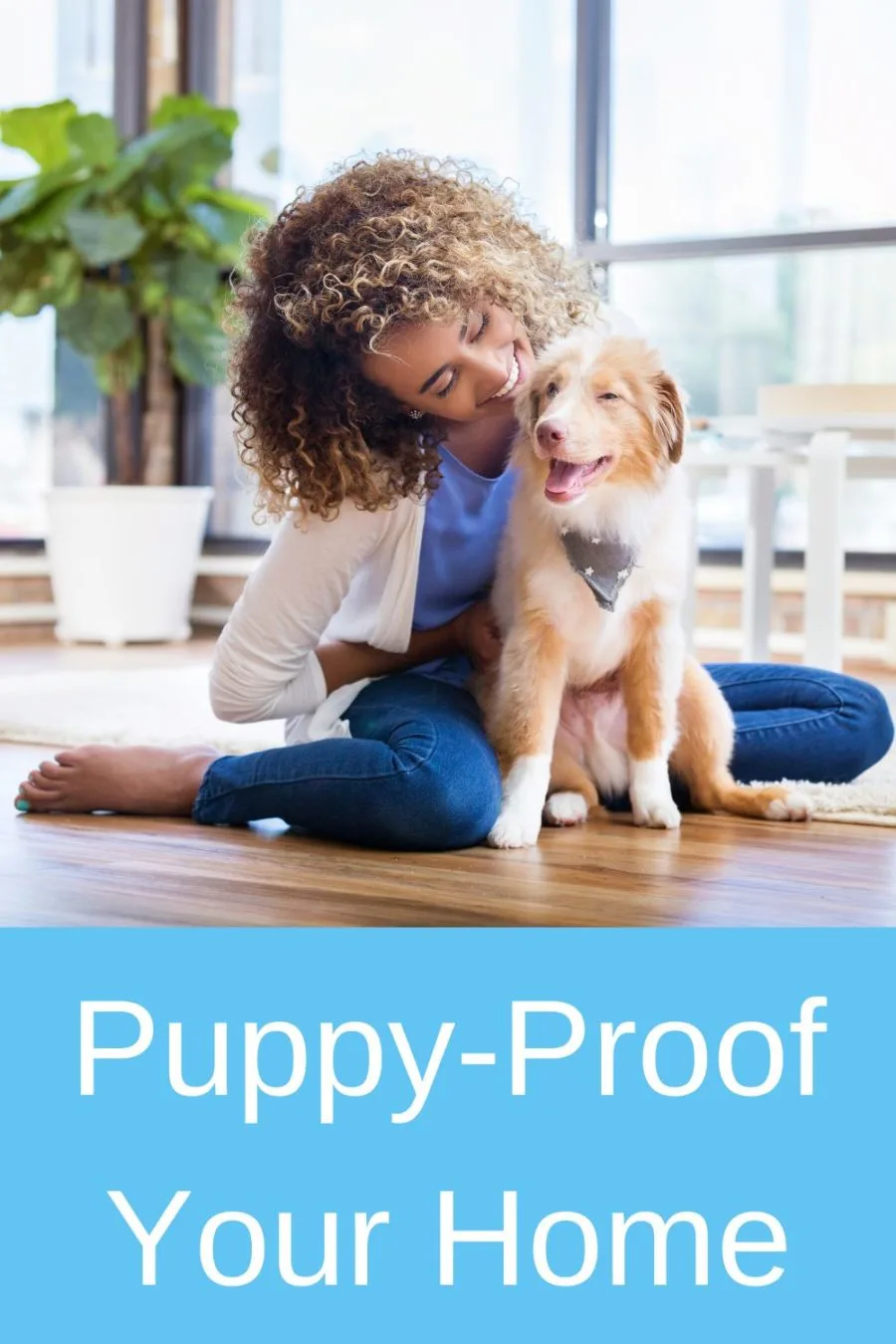There’s nothing like the joy a new puppy brings! But bringing home a new dog is about more than snuggles and play time. It’s your responsibility as a pet owner to make sure your house is equipped to handle a curious puppy.
From the house to the yard to being out and about, here are some best practices to keep your new puppy safe and out of harm’s way.

Around the House
Your dog will probably spend most of their time at home, so you should take plenty of time to puppy-proof your house before they come home. Look at everything from a curious dog’s point of view and make sure to secure any potentially dangerous objects.
Start by putting away anything that could be harmful if ingested. This includes medication, household cleaners, and body care products. Some human foods, indoor plants, and essential oils can also be toxic to dogs. Learn which products are safe to be around animals and put away or get rid of anything that isn’t.
Next, secure any electrical cords, small objects, or things that could be ruined if they get chewed on by a teething puppy. You probably don’t want your possessions to be destroyed, and you also don’t want your puppy to choke on something unsafe!
You may want to consider moving or covering some of your furniture as well. Consider how your furniture is arranged and take care of any gaps where a small puppy could get stuck. Make sure all shelves are secure so they can’t easily be knocked over. And cover any chairs or couches that you don’t want a puppy to scratch, chew, or get dirty.
One final recommendation for puppy-proofing inside the house is to get a sturdy trash can with a lid. Trash cans are full of interesting smells that would make any dog want to stick their head inside, and leaving the lid off is just asking your puppy to take a peek and chow down.
Check the Exits

Your puppy loves you and they love their home. But that doesn’t mean they won’t dart off if given the opportunity! Dogs are curious and social creatures. All it takes is one stray squirrel to capture their attention and send them running. It’s your responsibility to make sure all entry and exit points in your house and yard are secure so they don’t have the chance to run.
First, check all of the windows and exterior doors in your home. Make sure they close and latch properly, and consider keeping them locked when possible.
If you have an enclosed yard, examine the fence very closely to look for gaps or weak spots.
If you plan on letting the dog roam the yard unsupervised, the fence should be tall enough so that your puppy can’t jump over it. All gates should be functional and have strong locks.
Secure the Yard
Speaking of your yard, there are potential hazards outside of your home that should be taken care of as well!
Make sure there are no toxic plants that could harm your dog if ingested. Also, keep your grass trimmed and avoid letting brush or weeds pile up. Ticks are always a threat, but they’re more prevalent in tall grass.
Be cautious when treating your yard with pesticide, insecticide, or fertilizer, as some of these products can be very unsafe to use around animals. It’s best to rely on a professional company when treating your yard, and keep your dog away from treated areas.
If there is a pool in your yard, take extra care when securing it. Ideally, there should be a gate around the pool that prevents your dog from getting to the water. If there isn’t, make sure to always accompany your dog while in the yard to avoid any accidents.
Finally, be wary of the temperature when letting your dog stay outside. If your dog will be spending a lot of time outdoors, they should always have a shady spot to rest and plenty of water to drink. Of course, it’s best to supervise your dog if they are outside a lot, especially when they are young.
While Traveling
One of the best parts of being a dog owner is being able to take them places! From hiking the trails to running around at the dog park, a puppy can be your best adventure partner. But there are just as many hazards away from the home as there are inside it. The first step to keeping your dog safe in public is to always keep them on a leash. Even if your pup is well-behaved and you’re confident they won’t run off, you can never be too sure. Besides, keeping your dog leashed is the law in most public spaces.
Keep the information on your dog’s tags up-to-date and make sure they always wear their collar and tags when away from the home. That way, if your dog happens to get away, whoever finds them will be able to get them home safely. Having your pet microchipped can help with this too!
Finally, travel safely with your dog! Just like humans need to buckle up every time they’re in a vehicle, your pup should be properly restrained, too. If you take your dog on frequent car rides or are planning for a long road trip, consider investing in a canine safety restraint. This harness will keep your dog safe in case of hard stops, sharp turns, or potential accidents.
Around Water
Lots of dogs absolutely love water—some breeds more than others. But even if your puppy is a strong swimmer, skill is no match for dangerous water and strong currents. Use extra caution when taking your dog near lakes, rivers, or oceans. Of course, your dog should be on a leash at all times, but this is especially true when you’re around water.
If you do choose to take your dog swimming, be sure to use a life jacket designed for dogs. It will keep your dog afloat and make it easier for you to rescue them if they tire easily.
Don’t Forget about the Vet
No matter how many measures you take to keep your dog safe at home, nothing does more for your dog’s well-being than regular checkups at the vet. A veterinarian will make sure your dog follows a recommended vaccine schedule to stay protected against common canine diseases.
Your vet will also start your dog on parasite prevention. Fleas and ticks are a common threat to dogs of all ages, but starting treatment early—along with knowing how to spot heartworm symptoms in dogs—can help your puppy avoid serious health issues.
David Cruz is a freelance writer traveling the country with his beautiful Samoyed, Bosco, and his travel-nurse wife.
Pin it to remember best practices to puppy proof your home!

- Selecting the Best Online Emotional Support Animal Letter Service - December 14, 2023
- How to Store Dog Toys –10 Solutions to Organize Those Toys! - July 7, 2022
- Best Practices to Puppy-Proof Your Home - June 27, 2022
